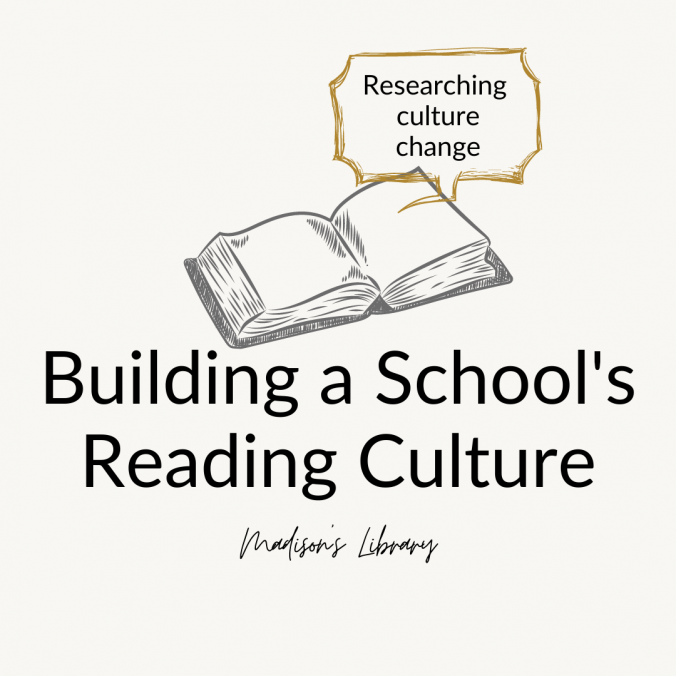Building A School Reading Culture – Part 3 Culture Change Research
In my last post on Building A Reading Culture, I shared my dive into the research around organisational culture. You can read my journey into building a reading culture from the start, in this first post Building A School Reading Culture Part 1 Getting Started.
When I decided to investigate the reading culture at our school, I wanted to do it properly and I was inspired to look beyond the school library context by my mentor, Dr Kay Oddone and her fantastic post on her website LinkingLearning. So, I began my journey within the business and organisation context. Looking at the research around organisational culture helped me to understand that culture is not only the “way things are done around here” but also the underpinning beliefs, values, assumptions and thoughts around the future of the organisation.
However, this is just a starting point. The true power rests in being able to change the culture we have.
Culture Change
Schein (2019) states that culture cannot be manipulated with quick fixes or revising a mission statement. It takes a long time to create true change. Heath (2021) suggests that to change an organisation’s culture you must discover what is driving behaviour. This is similar to what Pater (2015) suggests. Katzenbach, Steffen and Pronely (2012) provide a 5 point strategy. First you must match your change strategy with the culture. What does this mean? You can’t impose a strategy for change from above and expect it to change the culture that has existed for some time. The desire to change must be featured and promoted and the change will work best if what is promoted is aligned with the culture. This is all well and good, but what if what you are trying to change to sits outside of the current culture? Their second point might be helpful, to focus on just a few shifts in behaviour. It’s best to start small. Pick a few behaviours to target for change. Again the third point is helpful: Honour the strengths of the existing culture. Don’t throw out everything just because you want to enact change.
Culture Change Models
Bremer (2012 cited in Lee 2020) states that change is best enacted by engaging those within the organisation in the change process to contribute ideas, information and insights in how to improve the culture. Lee then draws upon a range of sources to provide 8 steps to culture change. They are
- A period of assessment of the current culture. This involves identifying the current values, as well as the desired culture.
- Identify positive examples of the desired culture that are currently happening. What are we already getting right, effectively. These can be anecdotal in nature.
- Outline the strategic initiatives. What will be enacted? Review the current processes and polices and come up with an action plan for change.
- Record progress and identify small wins. Look for small changes and celebrate these.
- What is success? Coming up with indicators of success and how these will be measured is key. Data gathering, measure, metrics, milestones and a range of other m words. How will you track your change?
- Communicate your change.
- Create a sense of urgency. Communicate regularly positive aspects of the environment. To this broadly and regularly.
- gather supporters, leaders and key individuals and involve them in the changes.
To me, this model seems out of step and not necessarily clear on how I should go about some of the steps. For example, why would I come up with the measures after enacting change? Wouldn’t I do that first? And the broad communication is great, but marketing tells me to get buy in I need to be specific and targeted in my communication.
Rick (2016) uses the word create to outline a six step approach to culture change.
C – clarify values and organisations culture.
R – reinforce the vision, ensuring everyone in the team knows the vision, values and culture code and how these will work towards success.
E – empower behaviours that support the values, culture and vision
A – align conversations
T – target efforts on high impact areas
E – emphasise success
While I like the simplicity of this model, I need more guidance on some aspects. For example, what exactly is align conversations? And how would I do that?
Fullan (2001) provides another angle: to create change one must first create a culture of change. They argue that while there are many examples of step-by-step guides on how to change a culture, that these do not effectively work and instead we should focus on leadership. They argue that out of six leadership styles, two have negative impacts on culture and the other four have positive impacts. The four positive leadership styles they suggest are authoritative, afflictive, democratic and coaching, while coercive and pacesetting leadership should be avoided. Instead of a step-by-step approach, Fullan suggests a range of skills and behaviour that can be used to drive change. These are
- Allowing time for those within the organisation to up skill and change behaviour and beliefs. This is especially true of those reluctant to change. Being empathetic to change and realise that it take time.
- Build trust and relationships, build enthusiasm, self confidence and clarity of vision.
- Listen to those in the organisation, especially those that disagree with the change. It is from these people that the most can be gained, relationships built.
A culture change approach
Ultimately, if culture is how we do things around here, change means changing how we do things around here. It needs to be practical (remembering culture sits on behaviour). Tait and Faulkner (2019) also cite listening as one of the key skills of change. They direct change, from their experience in schools across the world, by starting on a problem. This is different from many of the other approaches, who seem to start with a vision and mission. Instead, Tait and Faulkner lead their readers through a series of steps to identify your culture’s problem. This is something I intend to do with our school library team, as well as approaching it from the model of setting our vision and goals. We will compare both approaches and see if we reach the same direction for moving forward or if one or the other creates a different direction or consideration for us.
References
Fullan, M. (2001). Leading in a culture of change / Michael Fullan.
Heath, N. (2021). 5 ways to maintain positive culture change. In The Black. https://www.intheblack.com/articles/2021/02/01/positive-culture-change
Katzenback, J.R., Steffen, I., & Pronely, C. (2012). Culture change that sticks. Harvard Business Review, July-August. https://hbr.org/2012/07/cultural-change-that-sticks
Lee, J. (2020). Accelerating organisation culture change : Innovation through digital tools / Jaclyn Lee. http://onesearch.slq.qld.gov.au/permalink/f/1oppkg1/slq_alma21292251100002061
Pater, R. (2015). Advanced culture change leadership. Professional Safety, 60(9), 24-26. Retrieved from http://ezproxy.slq.qld.gov.au/login?url=https://www-proquest-com.ezproxy.slq.qld.gov.au/scholarly-journals/advanced-culture-change-leadership/docview/1709999607/se-2?accountid=13378
Rick, T. (2016). Create a culture change – Driving organisational culture change. Meliorate. http://www.torbenrick.eu/blog/culture/create-a-culture-change/
Schein, E. H. (2019). A new era for culture, change, and leadership. MIT Sloan Management Review, 60(4), 52-58. Retrieved from http://ezproxy.slq.qld.gov.au/login?url=https://www-proquest-com.ezproxy.slq.qld.gov.au/scholarly-journals/new-era-culture-change-leadership/docview/2269353958/se-2?accountid=13378
Tait, A., & Faulkner, Dave. (2019). Dream team : A practical playbook to help innovative educators change schools / Aaron Tait and Dave Faulkner.



Leave a Reply